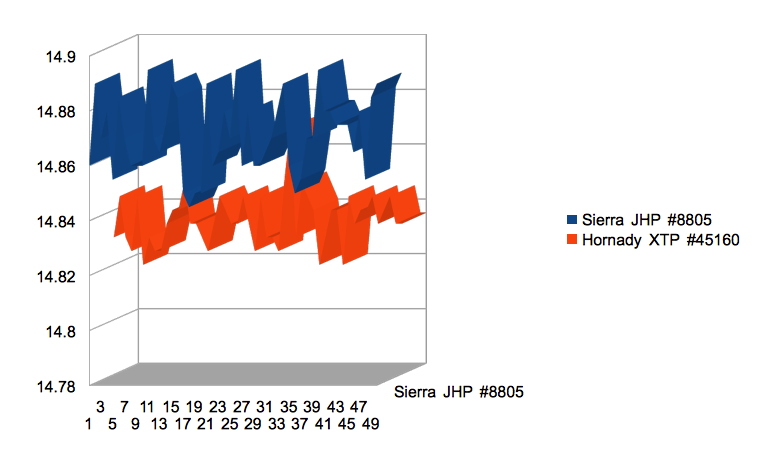

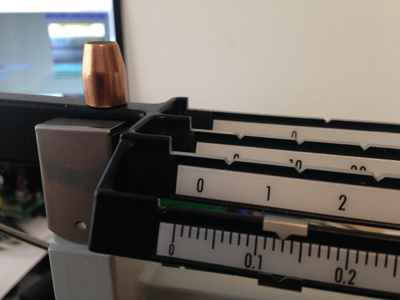
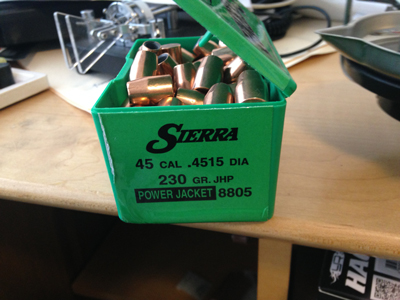
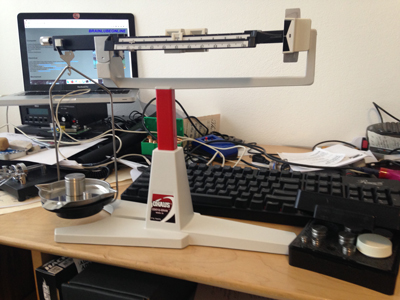
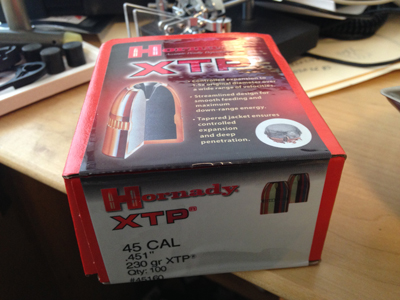
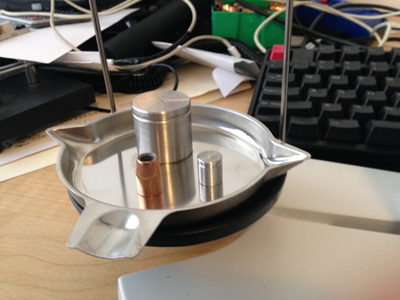
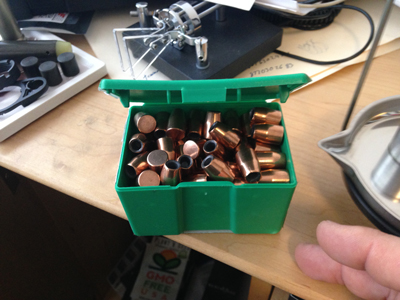

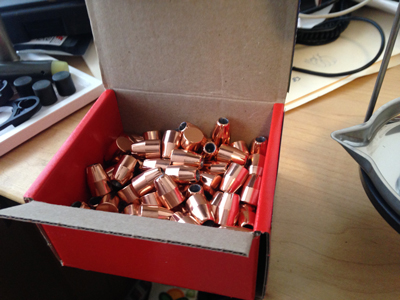
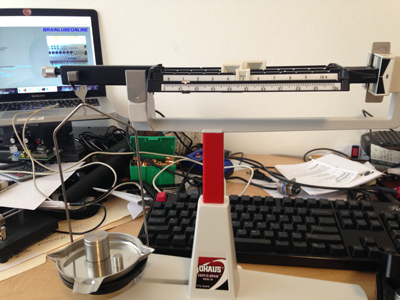

The above graph shows all 50 of the test sample weights (projectiles) from both the Sierra and the Hornadys. Notice that if you want a consistently heavier projectile you want the Sierra, if you want a more consistent weight you want the Hornady.
| SIERRA 45 Cal .4515 Dia 230gr. JHP Power Jacket 8805 | HORNADY XTP 45 Cal .451" 230gr XTP #45160 |
|---|---|
Ballistic Standard Deviation Calculator
Enter Velocities and Enter 0 when done
Input Velocities:
14.86
14.89
14.87
14.88
14.855
14.885
14.87
14.86
14.86
14.86
14.895
14.87
14.865
14.875
14.89
14.885
14.85
14.845
14.85
14.85
14.89
14.86
14.865
14.88
14.87
14.895
14.86
14.88
14.86
14.86
14.865
14.87
Extreme Spread: .05
High: 14.895
Low: 14.845
Mean Average Velocity: 14.8694
Standard Deviation: 0.0138491
3 Sigma: 0.0415472
Number of Samples: 32
|
Ballistic Standard Deviation Calculator
Enter Velocities and Enter 0 when done
Input Velocities:
14.83
14.845
14.83
14.825
14.845
14.82
14.83
14.825
14.825
14.835
14.84
14.84
14.85
14.835
14.835
14.83
14.825
14.835
14.845
14.84
14.835
14.835
14.845
14.835
14.825
14.845
14.83
14.83
14.825
14.85
14.87
14.83
Extreme Spread: .05
High: 14.87
Low: 14.82
Mean Average Velocity: 14.8356
Standard Deviation: 0.0100584
3 Sigma: 0.0301753
Number of Samples: 32
|
Amazingly, both the Hornady and the Sierra bullets had the exact same delta between each of their respective highest and lowest weights! .05 of a gram. (.77 grain)
Ultimately, if your projectile weight varies a great deal this can effect many things; accuracy, power, speed, and bullet drop to name a few. With pistol rounds though, minor deviations do not make that much of a difference. However, consistency is accuracy, and any rise in consistency is a rise in accuracy, no matter how small. These tests then, are more of a gauge of the quality of manufacture than anything else. Having stated this, it should be noted that a very real use of this data is in calculating power factors for your competition hand-loads. The smaller you can make your errors in bullet weight and powder weight. The smaller the velocity error when your rounds are tested for power. This may allow you to use a lighter charge than your normal standard deviation would comfortably allow.
USPSA rules for example as of the 2014 revision, calculate their power factor by the following: Power Factor = Bullet Weight (in Grains) * Avg. Velocity (in Feet/Second) / 1000.
It should also be noted that any decimals in the resulting calculation are truncated not rounded. For example a calculated result of 124.999999 is a Power Factor of 124.
This means when you are called to chronograph your loads, (lets say you need a Power Factor of 165 to make the "Major" class) and you have developed a load as close to 720 Feet per second as humanly possible a one grain error with a 230 grain projectile, could cost you the match. That is 230gr * 720fps / 1000 = 165.5 (meaning a PF of 165 the bare minimum PF to make major. Verses 229gr * 720fps / 1000 = 164.88 or a PF of 164. You're now cheating!
In reality you will never get your powders to give you anywhere near the accuracy of even a 10 fps difference from round to round, with practical reloading, but that's not the point. Every little bit of consistency helps you lower your velocity just a little bit.
To measure the bullets an Ohaus model 311 beam balance scale was used. It is officially accurate to .01 of a gram, but you can eyeball in between .01 of a gram graduations. I do not know if the scale is that accurate but I recorded down to .005 of a gram. To put this into perspective, 0.01 grams is 0.154324 of a grain. so we are at least (easily) within +- 1/3 of a grain accuracy. however it is most likely more like within +- 1/10th of a grain unofficially.
Here are some stats to get a feel for the numbers:
| Sierra Measurements | Hornady Measurements |
|---|---|
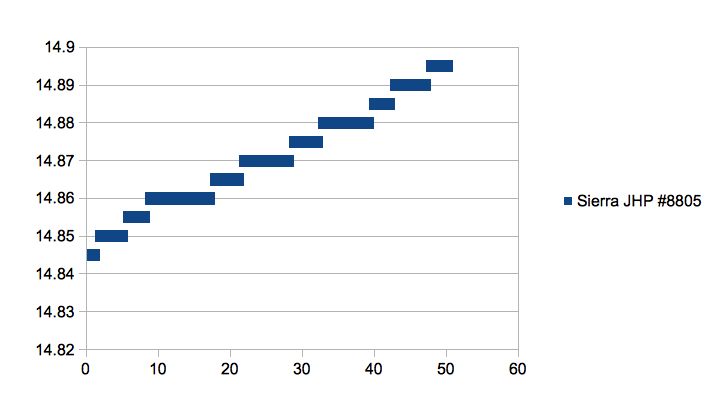 |
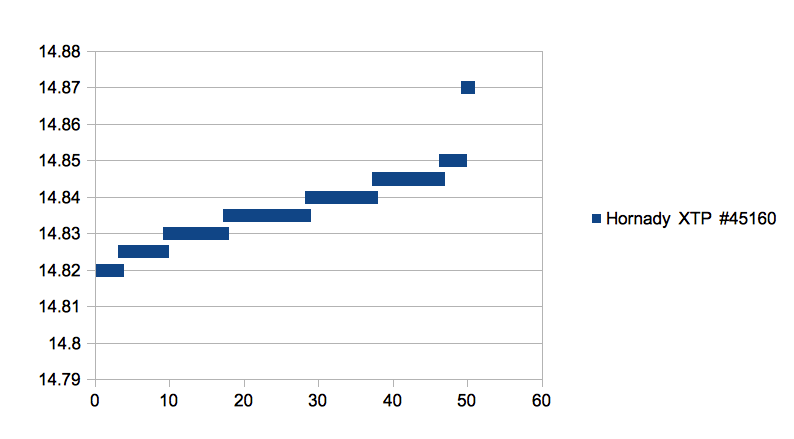 |
By the graphs you can see that although (amazingly) both bullet manufacturers have the same delta, or spread between the heaviest and lightest projectiles, the Sierras are much more evenly distributed than the Hornadys. With the the Hornady upper outlier removed, the variance drops to an amazing .03 of a gram! Hornady takes home the trophy by these numbers. It should be noted of course that both of these rounds are of superior quality and we really are splitting hairs here. A .05 gram difference = .77 of a grain, and a .03 gram difference is amazingly less than half a grain!
Someone might ask why I did not simply use a powder measuring scale for these tests. The answer is, that although they are finer measurements, I could not get as repeatable results as I could with the Ohaus.